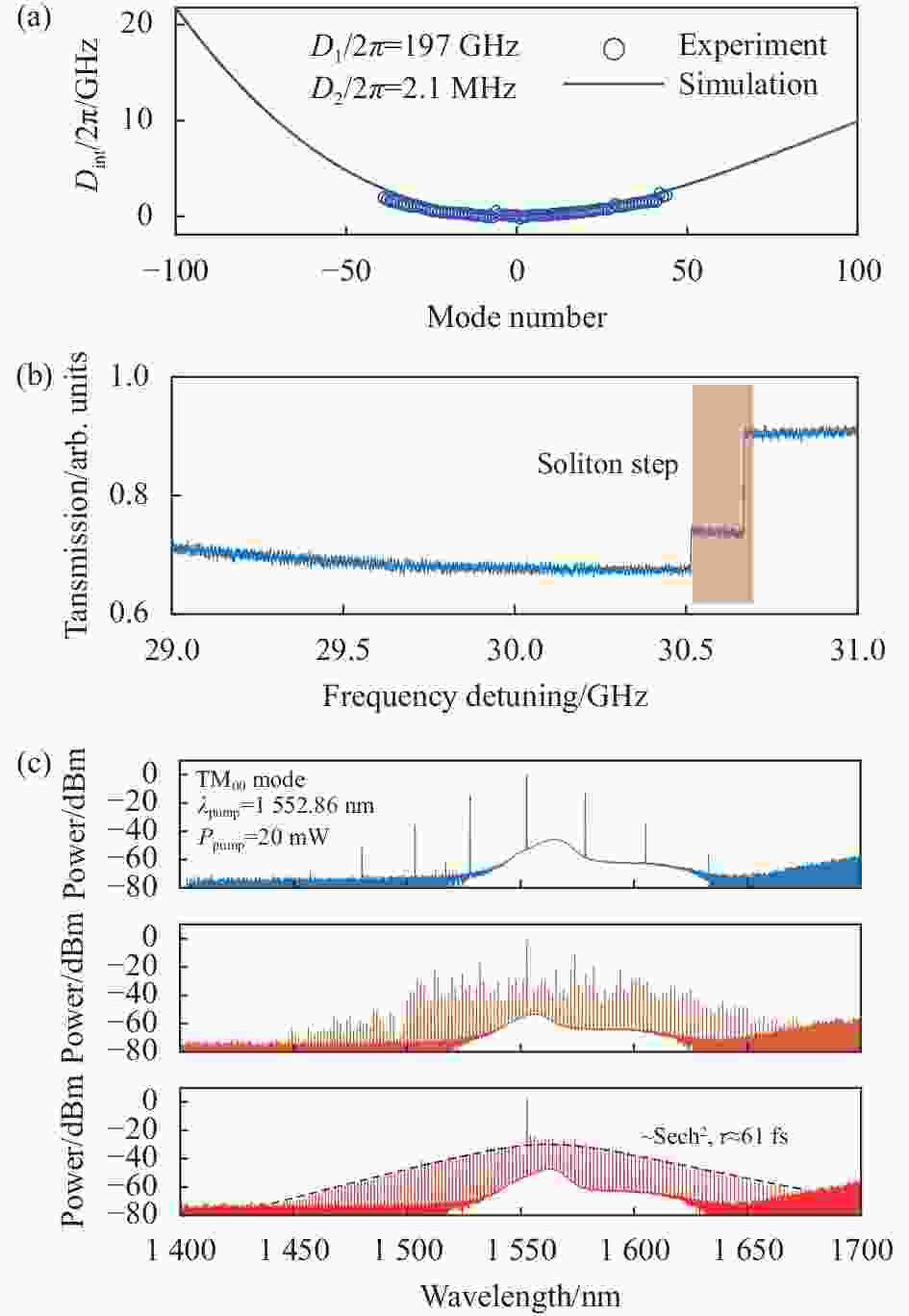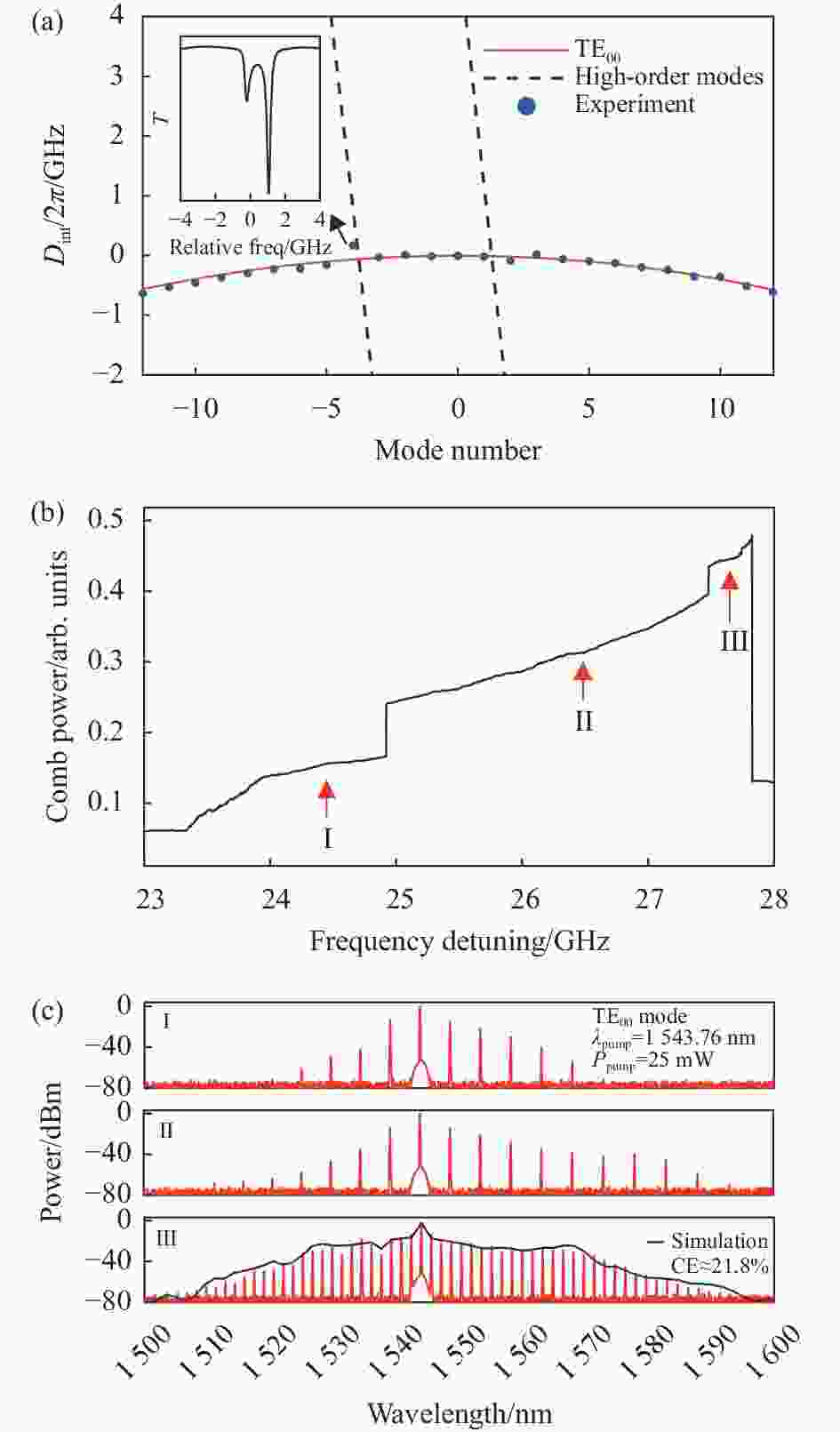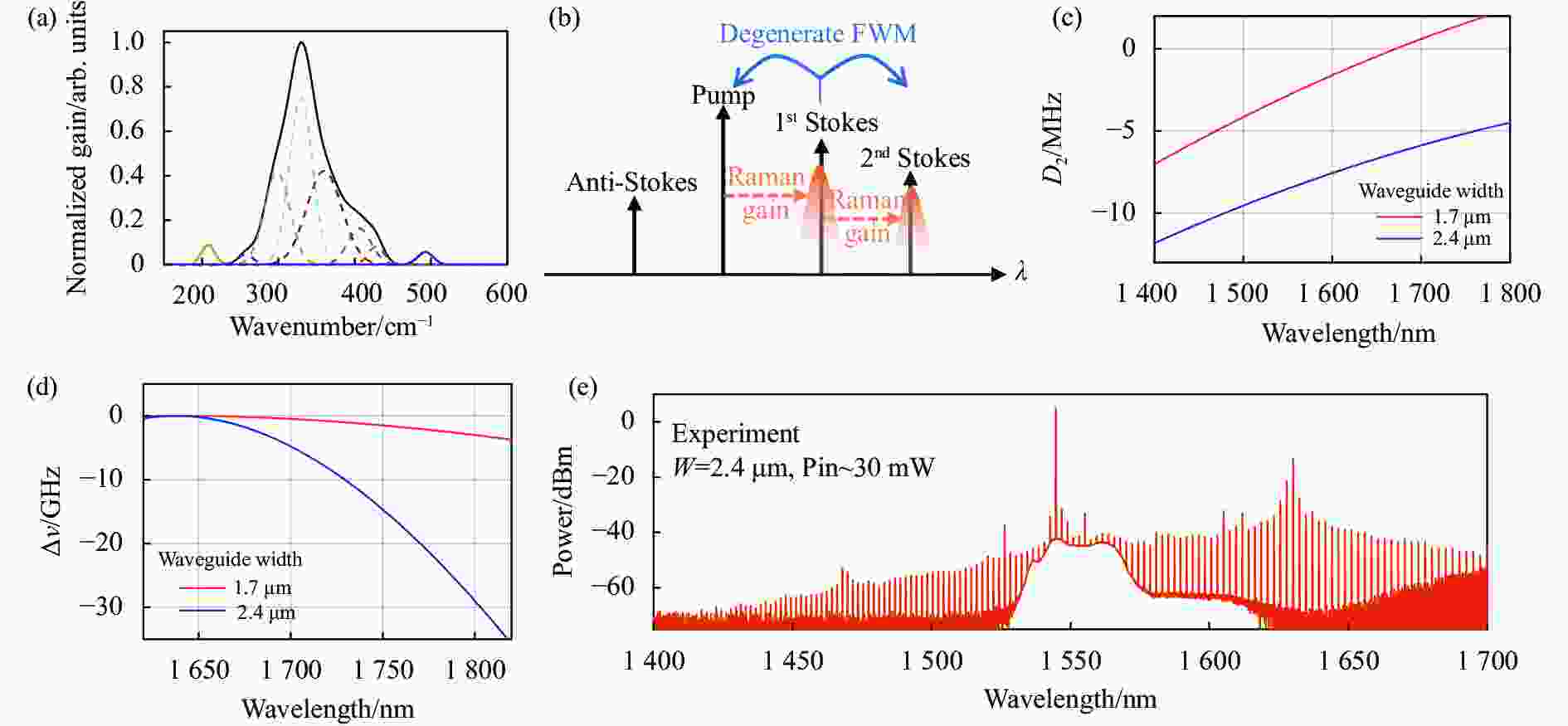-
光学频率梳是一种由等频率间隔的激光模式构成的梳状光谱,在频域上呈现为一系列相同间隔的光频率分量,在时域上为等周期的超短脉冲序列[1-2]。因具有光学模式间隔相等、相位关系恒定的特性,光学频率梳在光学时钟[3]、精密光谱[4]、频谱测量[5]、光学传感以及光信号处理[6-7]、量子光学等领域得到广泛研究和应用[8]。
近年来,基于集成光学微腔的光学频率梳(集成微梳)具有高重频、低泵浦阈值、高集成度等优势,有效解决了传统的光学频率梳存在的系统体积大、成本高、重复频率低等问题,极大地拓展了光学频率梳应用场景[9-11]。集成微腔光梳的产生依赖于高品质光学微腔中显著的参量四波混频效应,这一过程将泵浦光转移到微腔的各个模式中从而形成光频梳。当微腔色散与克尔效应、损耗与增益之间达到平衡时,腔内就会产生时域光孤子,在频域上对应于锁模的、梳齿等频率间隔分布的光学频率梳。因此,集成微梳的性能主要取决于集成微腔的非线性特性和光学损耗[12]。近年来,许多材料平台,如硅、氧化硅、氧化钽、铝镓砷、铌酸锂、氮化硅、碳化硅、氮化铝、氮化镓等,被用于制备光子微腔并产生光频梳,这些光子微腔具有各自的优势和不足[13-21]。而且,目前集成微腔光频梳输出波长主要集中在近红外波段,若材料平台具有更宽的透光波段,集成微梳可在新波段得到更广泛的应用,如中红外精确光谱探测[22-23]。因此,为产生更加集成化、低功耗、大带宽的光学频率梳,开发具有宽透光窗口、高非线性、高光热稳定性和易于片上规模化异质异构制备的材料平台成为迫切的需求[13, 24]。
硫系玻璃材料具有高的线性和非线性折射率、超宽透光窗口、在通讯波段无双光子吸收、高拉曼增益系数和声光系数等特点[25],在非线性光子学领域得到深入的研究,已在硫系光纤或波导中成功产生了宽带超连续激光[26]、宽带拉曼激光[27]和高增益受激布里渊散射[28]。作为非晶材料,硫系薄膜可以直接通过低温热蒸镀(低于350 ℃)沉积在硅基平台[29],且可通过热处理进一步降低薄膜的表面粗糙度[30]。然而,常用的硫系片上光子器件因含砷存在易被氧化、激光损伤阈值低等问题,通过常规微纳加工工艺难以制备超低损耗集成光子器件,限制了硫系集成光子器件在非线性光子学领域的发展。
近年来,笔者研究团队开发了新型Ge25Sb10S60 (GeSbS)硫系材料基光子集成器件。GeSbS材料具有较高的激光损伤阈值,其较高的玻璃化转变温度与CMOS工艺也更加兼容。通过优化硫系微腔的微纳加工工艺,基于GeSbS硫系薄膜制备了一系列高品质因子(Q>106)的硫系微环谐振腔。表1对比了目前片上硫系微腔的一些性能参数,来自韩国KAIST的Kim等人在As2S3微腔中实现了超过107的高品质因子,然而该器件的波导尺寸过大而无法实现色散调控,且As2S3本身激光损失阈值较低,不利于实现集成微梳。可以看出,笔者所开发的GeSbS体系拥有满足色散调控条件下最高的品质因子,且该体系性质稳定,激光损失阈值高,在实现基于硫系平台的集成微梳方面具有显著的优势。如图1所示,文中将综述笔者研究团队通过对硫系集成光子器件在不同偏振态和波段精确的色散调控,分别在该硫系集成微腔内产生了锁模的孤子光学频率梳和宽带拉曼-克尔光学频率梳。
Ref. Material n n2/m2·W−1 Dimensions/μm2 Q DEa at 1.55 μm [30] As2S3 2.43 3.0×10−18 10×1.3 1.4×107 N [29] As2S3 2.43 3.0×10−18 2.0×0.85 1.3×106 Y [31] Ge11.5As24Se64.5 2.66 8.6×10−18 0.85×0.48 3.0×105 Y [32] Ge28Sb12Se60 2.80 5.1×10−18 0.8×0.48 4.1×105 Y [33] Ge23Sb7S70 2.15 0.9×10−18 0.8×0.45 7.5×105 N This work [34] Ge25Sb10S65 2.23 1.4×10−18 2.4×0.8 2.1×106 Y a: DE: dispersion engineering. Y, yes; N, no. Table 1. Comparison of the on-chip chalcogenide microresonators
-
高品质因子的光学微腔是实现增强光和物质相互作用、降低微腔中非线性效应阈值的重要基础。通过引入硫系材料靶材的化学-物理提纯技术和优化薄膜沉积工艺,在4 in (1 in=2.54 cm)硅基晶圆上实现了厚度(±6.5 nm)和折射率(±0.0075)均匀性优异的硫系薄膜的批量稳定制备。通过优化片上集成硫系材料的微纳加工工艺,进一步降低光学微腔侧壁的散射损耗,获得了高品质因子的硫系集成光学微腔,为集成光学频率梳的产生提供了高品质光子器件[29, 34-37]。
图2(a)展示了优化后的GeSbS波导制备工艺[34]。首先将沉积在硅晶圆片(氧化硅薄膜厚度≥2 μm)的GeSbS薄膜在玻璃化转变温度附近进行热退火处理,有效降低了GeSbS薄膜的表面粗糙度。通过优化的退火工艺,测量得到5 μm×5 μm区域的薄膜表面粗糙度的均方根从退火前的0.62 nm降低到0.24 nm[34]。对电子束光刻图案化后的薄膜进行热回流处理,降低薄膜上表面光刻胶的粗糙度。紧接着转移到电感耦合等离子体反应离子蚀刻机(ICP-RIE)中对GeSbS波导进行干法刻蚀。通过优化混合的CHF3/Ar刻蚀气体配比和刻蚀参数,最终得到近乎垂直的波导侧壁(如图2(b)所示)。对比之前报道的加工工艺的结果可以看出,获得了更加光滑的波导侧壁结构,这对之后精确控制微腔色散产生不同类型的非线性效应奠定了基础。最后通过电感耦合等离子体化学气相沉积工艺(ICP-CVD)在获得的微腔器件上表面沉积一层3 μm厚的二氧化硅包层。如图2(c)所示,通过上述优化工艺步骤,成功地降低了硫系波导中表面散射损耗,制备出高品质的片上集成GeSbS微环谐振腔。如图2(d)~(i)所示,通过制备的集成硫系微腔的线宽及其分布特征进行表征,发现高折射率差的GeSbS微环谐振腔可以同时支持TE00和TM00模式族的传输且具有很强的束缚能力,对应的两个基模模式族的本征线宽分布在100 MHz左右,本征Q值均超过了106。

Figure 2. Fabrication process of high-Q GeSbS microresonators and linear transmission characterization[34] . (a) Fabrication procedure of GeSbS microresonators based on RIE-ICP etching; (b), (c) Top view and cross section view of scanning electron microscopy (SEM) of a GeSbS microresonator with a radius of 100 μm; (d), (g) Experimentally measured transmission spectra of TE00 and TM00 mode in fabricated devices, showing linewidths to be 144 MHz and 204 MHz from the Lorentz fitting curves; (e), (h) Corresponding mode distributions of TE00 and TM00 mode; (f), (i) Measured intrinsic linewidth distributions of TE00 and TM00 mode
-
近年来,笔者课题组始终致力于实现基于硫系玻璃材料的高性能片上集成非线性器件。2020年,在As2S3微腔中实现了非线性参量振荡,对应的参量振荡阈值功率低至约5.4 mW[29]。之后,通过进一步优化材料体系,选用了性质更加稳定的三元组分GeAsS并制备了低损耗微腔,实现了基于硫系材料的集成克尔光频梳,但未实现孤子锁模,产生频梳相干性较差[38]。因此,开发了Ge25Sb15S60新组分硫系体系,相较于GeAsS体系,它不含有毒、易氧化的As元素,具有更高的激光损失阈值和玻璃化转变温度,与CMOS加工工艺的兼容性也更好,因此在该集成微腔光子器件中实现了锁模孤子微梳[39]。
图3展示了基于GeSbS硫系微腔产生亮孤子微梳的代表性结果。克尔微腔光梳的产生依赖于微腔内高效的非线性四波混频过程,因此色散调控对克尔微梳的产生至关重要。通过利用几何结构色散补偿材料本征色散的方法,在宽度2.4 μm、高度0.8 μm的微环中设计两个偏振态对应的TE00模式和TM00模式具有不同的色散特性。其中,TE00模式具有正常色散可产生暗脉冲微梳,而TM00模式具有反常色散可产生亮孤子微梳。在色散测试中,使用光纤MZI干涉条纹对微腔谐振模式的频率间隔进行校正得到微腔的色散。如图3(a)所示,实验测得该微腔的TM00模式具有反常色散,且与仿真计算结果吻合。如图3(b)所示,通过在实验中设置泵浦波长约为1552.86 nm、泵浦功率约为20 mW并往长波方向扫描泵浦光,记录泵浦光的透射曲线可以发现明显的“台阶”,表明微梳进入了锁模的孤子态。图3(c)展示了该调谐过程中输出光谱的演变过程,该微梳经历了主梳、调制不稳定梳和锁模孤子微梳三个过程,最后所得的孤子微梳覆盖波长范围约为1450~1700 nm,重频约为197 GHz。该光谱具有典型的双曲正割包络,整体光谱平滑,通过拟合推测该孤子微梳对应时域脉冲的半高宽约为61 fs。值得注意的是,得益于该硫系微腔的低损耗、高非线性和较低的热光系数,该孤子微梳的激发无需复杂的泵浦调谐装置或者辅助激光,这有利于孤子微梳的全片上集成制备和实际应用。

Figure 3. Bright soliton comb generation in a GeSbS microresonator[34]. (a) The calculated and measured resonator dispersion for TM00 mode with a radius of 100 μm, and the cross-section is 2.4 μm×0.8 μm (width × height), respectively; (b) Transmission spectrum of the resonance when a laser is swept with a higher pump power, the "soliton step" can be observed; (c) The measured optical spectra as the pump laser is red-detuned into the cavity resonance (top to bottom), the pump power is fixed at ~20 mW
-
相较于在反常色散区产生的亮孤子微梳,在正常色散区产生的暗脉冲孤子光梳具有更高的转化效率,在特定波长范围内具有更加平坦的梳齿分布[40-41]。上述提及的相同尺寸的GeSbS微环的TE00模式具有和TM00模式完全不同的色散特性,可实现暗脉冲微梳的激发。图4展示了基于GeSbS硫系微腔产生暗脉冲微梳的代表性结果。不同于亮孤子微梳的激发,暗脉冲微梳的激发通常需要泵浦具有局部反常色散的特定模式,这种局部的反常色散是由于模式之间的相互耦合导致的。如图4(a)所示,通过仔细分析所制备微腔的TE00模式的色散曲线,发现TE00模式的整体色散表现为正常色散 (对应TM00模式具有反常色散),且存在模式耦合点,进一步模拟计算该微腔的高阶模的色散,证实了该模式耦合来自于基模和高阶模之间的相互作用,表明该谐振位置可实现暗脉冲频梳的产生。

Figure 4. Dark-pulse comb generation in a GeSbS microresonator[34]. (a) The measured dispersion curve of the same GeSbS microresonator in TE00 mode. Dashed and solid lines show the simulated integrated dispersion of the TE00 mode and high-order mode. Blue circles represent the measured integrated dispersion of the TE00 mode; (b) Normalized comb power when the laser was scanned from the blue side to the red side with high power; (c) The measured output optical spectra of dark-pulse combs at different stages as indicated in (b), black line denotes the simulated spectrum in stage III, the pump power is fixed at ~25 mW
如图4(b)所示,在实验中设置泵浦波长为1543.76 nm,泵浦功率约为25 mW,从短波往长波方向扫描泵浦光,在输出端滤出泵浦激光并记录频梳功率的演变过程,发现该微梳经历了三个阶段。图4(c)展示了三个不同阶段测试所得的光谱结果,首先产生了间隔为三个自由光谱范围间隔的微梳,进一步调谐微梳带宽增加,并最终得到了覆盖1500~1600 nm、重频约为200 GHz、转化效率约为21.8%的暗脉冲微梳。同时,将测试所得的微腔参数代入到理论模型进行仿真,也得到了与实验结果几乎吻合的暗脉冲微梳,进一步验证了实验所产生的微梳为暗脉冲微梳。该实验结果表明基于硫系玻璃的材料特性和灵活的微纳加工工艺兼容性,可在硫系集成平台中实现高性能的锁模微梳,为硫系集成光子平台在中红外波段的研发和应用提供良好的支撑。
-
在常规的正常色散下,光参量振荡因不满足相位匹配条件不能自发产生,因此无法产生克尔微梳。但GeSbS材料同时具有宽带的拉曼增益和强克尔效应,在微腔中拉曼效应与克尔效应的相互作用为光频梳的产生提供了一种新的途径[37]。图5展示了基于GeSbS硫系微腔产生宽带拉曼-克尔微梳的代表性结果。受激拉曼散射是泵浦光与非线性介质的光学声子相互作用的过程,在增益谱范围内其相位匹配条件是自动满足的,对微腔色散没有特别的要求。在常规的正常色散下泵浦时,拉曼效应会占据主导地位首先产生拉曼激光,当微腔内泵浦功率较大时,在拉曼效应的辅助下会产生四波混频效应,通过微腔的色散调控可以实现对四波混频效应的调控,如图5(b)所示。在泵浦、一阶Stokes光和二阶Stokes光之间的频率失配量较小时会产生拉曼级联现象;而通过增大这三个光波间的频率失配量则可以抑制拉曼级联,使泵浦能量转移到拉曼激光和泵浦光附近并产生频率边带,最终形成拉曼-克尔频梳[37]。

Figure 5. Raman-Kerr comb generation in a GeSbS microresonator[37]. (a) Measured Raman spectrum of GeSbS film with a thickness of 0.8 μm; (b) Schematic of the degenerate FWM between the pump wave, the first and the second Stokes waves; (c) Calculated dispersion curve for TE00 mode of the microresonators, with different waveguide widths (1.7 and 2.4 μm); (d) Calculated phase mismatch of the degenerate FWM process for (c); (e) The measured Raman-Kerr comb when increasing the pump power to ~30 mW in the 2.4-μm microresonator
在图5(c)和(d)中分别给出了宽度为2.4 μm的微环谐振腔的TE00模色散和对应的频率失配量,该微腔尺寸与上节中产生暗孤子频梳的微环谐振腔尺寸和模式相同。将微环谐振腔色散设计为强正常色散以抑制拉曼级联的产生。在实验中,设置泵浦波长为1544.78 nm、片上泵浦功率约为30 mW时,调节泵浦波长从短波向长波扫过谐振峰,并记录实验光谱。在扫描过程中,首先产生了拉曼激光,随着泵浦与谐振峰失谐量的减小,在四波混频作用下泵浦和拉曼峰附近产生了拉曼-克尔频梳,并最终形成覆盖1450~1700 nm的宽带频梳,如图5(e)所示。使用图5(c)中的两种色散曲线代入理论模型,数值求解微腔内非线性演化过程,所得仿真结果也与实验结果吻合的很好,进一步验证了笔者的理论设计。该研究结果为微腔中克尔效应与拉曼效应的相互作用提供了新的见解,并且具有实现紧凑、高性能的分子探测器件的潜力[42]。
-
文中主要总结了笔者研究团队在自主开发的GeSbS硫系集成微腔中产生光学频率梳的最新进展。硫系集成光子器件具有宽带透过性、高非线性、灵活的微纳加工工艺兼容性等特点,为片上集成光学频率梳的产生和应用提供了新的平台。首先总结了最新的高品质硫系微腔的制备工艺路线,重点介绍了基于新型硫系材料实现的一系列的片上集成微梳,包括亮孤子微梳、暗脉冲微梳和拉曼-克尔微梳。虽然所介绍的工作仍主要集中在通信波段,未来通过设计和制备全硫系的片上集成波导可以进一步拓展微腔光频梳至中红外波段[26]。此外,硫系材料具有高的布里渊增益,已经在硫系微腔中产生了布里渊激光[28]。基于布里渊激光频率稳、线宽窄的优点有望实现高性能的布里渊-克尔微梳[43],从而在微波光子领域发挥重要作用。
Integrated chalcogenide frequency combs (Invited)
doi: 10.3788/IRLA20220312
- Received Date: 2022-05-07
- Rev Recd Date: 2022-05-12
- Publish Date: 2022-06-08
-
Key words:
- chalcogenide glasses /
- integrated optical microresonators /
- nonlinear integrated photonics /
- soliton microcombs
Abstract: Chalcogenide glass integrated microresonators (chalcogenide microresonators) have attracted great attention in nonlinear integrated photonics in recent years because of their high linear refraction index, high nonlinearity coefficient, ultra-wide transmittance window, low thermo-optic coefficient, and precisely regulated dispersion with conventional semiconductor micro-nanofabrication technology. Recently, the researchers from the Sun Yat-sun University developed a novel chalcogenide glass (Ge25Sb10S65) material platform and realized a series of high-quality chalcogenide integrated photonic devices. The progress of integrated soliton microcombs generation and regulation based on chalcogenide microresonators was reviewed. The integrated chalcogenide microresonators with high-quality factors(Q>106) were achieved by a modified nanofabrication process. Furthermore, mode-locked soliton microcombs with a low pump power and a widely tunable Kerr-Raman comb were achieved by precisely controlling the dispersion , respectively.











 DownLoad:
DownLoad:



